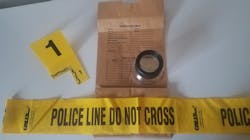In the heat of the moment when you are in the middle of dealing with an incident you may not always want to take the time to stop and review the physical evidence you have. Chances are when the chaos ensues you may miss a piece of evidence. (we have all been there) However, if you are ever on scene and you have that nagging feeling you are missing something, or you have that thought that makes you think twice about a piece of evidence, listen to that. That is not a feeling to ignore.
Crime scenes and evidence rely heavily on science and fact. These elements go hand in hand with the rest of an investigation. No part of a case can survive without the other. A crime scene and physical evidence is no good without interviews or the first responding officer’s observations. Each aspect of investigation comes together in one, orchestrated movement. This is why it is so important that officers understand the crime scene and evidence side of an investigation and for crime scene technicians’ to understand the officer’s role as well.
One type of evidence that I have found is often overlooked are shoe prints and impressions. It is so easy to disregard this type of evidence or to snap one quick photo, and call it good. However, there is now an entire database dedicated to this type of evidence, which means there is extreme importance there.
Case Example
Say you have a prowler case. The victim calls and says a subject has been sneaking around their property and peeking into their house. Officers go to the scene and in the process locate the subject based on the victim’s description of them. At the scene, there are several shoe prints on the front porch as well as shoe impressions in the backyard. What is the most efficient way to handle this evidence?
Firstly, both the subject’s shoes and the prints should be photographed with a measuring scale next to them. This shows the exact length of the shoe which in turn can help prove the subject’s shoe and the shoe prints are one in the same. If there are shoe impressions they should be cast with plaster. The subject’s shoes should also be collected as evidence and a print of their shoe should be taken for comparison. This may be done by using a light dusting of fingerprint powder and pressing the shoes on paper. Each step of the process should be photographed meaning at the scene as well as when evidence is processed.
Secondly, the tread of the shoe is important. This should also be photographed well and carefully documented with detailed descriptions.
Importance
You may be thinking, “if the subject is identified on scene why go to all of this trouble”? The reason may not be clear at the time of the incident or even when you are in the middle of the investigation. When you get to the other end of the investigation is often when this type of evidence becomes center stage. For instance, in regard to the case example above, say you have an eye witness statement and the victim identifies the subject in a line up. When the case goes to court, the defense is going to look for any angle they can in order to lessen the sentence. If in the report there were known shoe prints, every step needs to be taken in order to seal the deal for court.
All of us want air tight cases, ensuring each and every detail of evidence is taken care of properly will only help strengthen your case.
About the Author

Hilary Rodela
Hilary Rodela is currently a Surveillance Officer, a former Private Investigator, a former Crime Scene Investigator, and Evidence Technician. She worked for the Ruidoso (NM) Police Department as well as the Lubbock (TX) Police Department. She has written for several public safety publications and has extensive law enforcement and forensic training and is pursuing forensic expertise in various disciplines. Hilary is a freelance public safety writer and curriculum developer for the National Investigative Training Academy.
